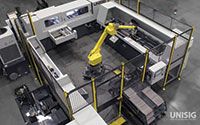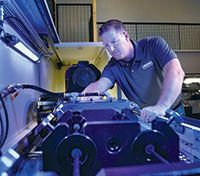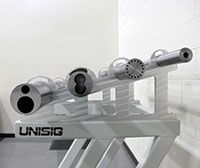by Jeff Price
Preparation is the first step to successful runs and positive margins on each job
Books have been written on how to produce deep holes using milling machines or lathes, but trying to drill deep holes with depth-to-diameter ratios greater than 15:1 (D:d) using standard machining centers often leads to frustration, costly scrap and poor use of a shop’s resources. And when it comes to those jobs with D:d ratios of 20:1, 100:1, or even 200:1, that frustration is magnified because the operation requires specialized equipment and knowledge that even the most seasoned mill or lathe operators often lack. With deep holes becoming a prerequisite for parts in multiple industries, job shops and suppliers need to supplement their existing experience and capabilities with the expertise of deep hole drilling specialists.
The starting point for these demanding hole-making applications is preparation and consultation with a deep hole drilling equipment supplier. This supplier must have a thorough understanding of the engineering that’s necessary to efficiently produce the tolerances, hole depth, concentricity and surface finish required. In addition, the supplier must be a willing partner, one that can guide a shop’s operators as they develop their own deep hole drilling expertise.
 Deep hole drilling system providers should begin all deep hole drilling projects by asking the difficult questions that allow a supplier to truly understand what the customer is looking for. The answers will enable the supplier to determine the proper deep hole drilling solution and also identify the degree of difficulty.This, in turn, dictates how to manage project expectations.
Deep hole drilling system providers should begin all deep hole drilling projects by asking the difficult questions that allow a supplier to truly understand what the customer is looking for. The answers will enable the supplier to determine the proper deep hole drilling solution and also identify the degree of difficulty.This, in turn, dictates how to manage project expectations.
Providers need to determine what tooling is required, whether its BTA, standard gundrill or newer, indexable gundrill tooling. This can be based on a number of factors, such as the project’s D:d ratio, whether the holes are on or off-centre, the desired hole tolerance, and the priority of cycle time versus accuracy. This decision will indicate the appropriate machine for the job. Additionally, workholding and fixturing must be factored into the decision, along with required production levels.
If accuracy is paramount – which is often the case for medical and oil tool applications – counter-rotating the workpiece in one direction and the tool in the other provides the most accurate hole and highest level of concentricity. Rotating only the workpiece with a stationary tool offers the next best accuracy for round parts with on-centre holes. Rotating only the tool as it enters a stationary part is typically used for non-symmetrical components or round parts with off-centre holes. As a byproduct, this method will have more drift than the other options. For some applications, however, this makes sense, as drilling speed may be more important than accuracy.
 Some deep hole drilling projects require equipment modifications that increase a machine’s capabilities to meet specific application needs. These system changes could include the addition of a drop bed that allows
Some deep hole drilling projects require equipment modifications that increase a machine’s capabilities to meet specific application needs. These system changes could include the addition of a drop bed that allows
for workpiece swing, which is required to rotate a part for sufficient drill access. Alternately, multiple spindles may be incorporated to increase throughput. And automatic loading and/or unloading systems – like robotics, servo-driven gantries, magazine loaders or internal walking beams – may be added to improve production and relieve operator time to add value to other processes.
 Answers to questions about a deep hole drilling application may also be used to select and modify a system to incorporate state-of-the-art technologies. A properly chosen gundrill, for example, can transform a challenging job with an extreme D:d ratio into an easily handled, profitable venture for veteran manufacturers or job shops embarking on their first deep hole drilling endeavor.
Answers to questions about a deep hole drilling application may also be used to select and modify a system to incorporate state-of-the-art technologies. A properly chosen gundrill, for example, can transform a challenging job with an extreme D:d ratio into an easily handled, profitable venture for veteran manufacturers or job shops embarking on their first deep hole drilling endeavor.
No successful deep hole drilling project is complete without ongoing on-site training. To achieve success, mill or lathe operators must quickly learn and understand deep hole drilling processes. This education, together with the knowledge and experience of deep hole drilling system providers, ensures a shop’s future projects are successful and profitable. SMT
Jeff Price is vice president of sales at UNISIG Deep Hole Drilling Systems
